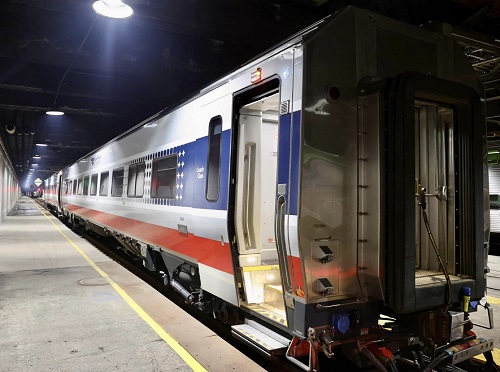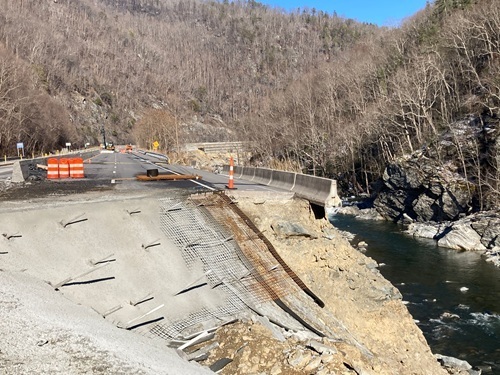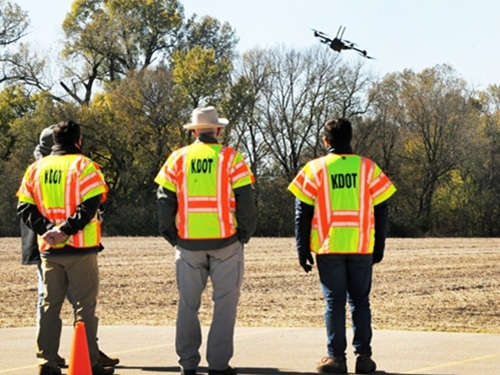Governor JB Pritzker and the Illinois Department of Transportation helped celebrate the start of 110 mph passenger rail service between Chicago and St. Louis. This $1.96 billion multi-year project results in better connections for Illinois communities and major institutions while improving safety, convenience, and accessibility, the agency said.
[Above photo by the Illinois Governor’s Office]
Starting with trains on Amtrak’s state-supported Lincoln Service, the higher speeds are eliminating approximately 15 minutes from the previous 90 mph runtimes between the two cities and 30 minutes from the initial 79 mph schedule in place when the project broke ground.
“Illinois is the only state where all seven of the nation’s largest railroads operate. That’s a unique economic advantage recognized by employers across the globe, helping our state attract and maintain quality jobs,” the governor noted in a statement.
“By upgrading to higher-speed service on Illinois’ largest passenger rail line, we are solidifying our status as the transportation hub of North America,” he said. “Investments like these do more than just connect cities – they allow our residents to access opportunities beyond their immediate neighborhoods, streamline regional collaborations, and open doors for new jobs and new businesses.”

In addition to increasing speeds, the project boosted safety and reliability for passengers while upgrading stations and opening new ones, Illinois DOT said. Ride quality was also enhanced up and down the corridor for both passenger and freight service on the Union Pacific Railroad, thanks to the addition of new concrete ties along the route and improvements to bridges, culverts, and signaling systems.
Major upgrades were performed at 212 grade crossings by installing four-quadrant gates and loop detectors to help prevent collisions with vehicles on the tracks. Pedestrian gates and fencing were built to protect people crossing tracks passing through towns and neighborhoods. Thirty-nine crossings deemed at-risk were permanently closed.
The project also built new stations in Dwight, Pontiac, Carlinville, and Alton, renovated the Lincoln station, improved the existing Normal station, and made upgrades to the Springfield station. A separate project to build a new multimodal station in Joliet was completed in 2018, with a second phase starting in 2021, the Illinois DOT noted.
The facilities provide a better customer experience and amenities, such as free Wi-Fi and connections to bicycle and pedestrian facilities. The new and improved stations act as gateways to their communities, inviting tourism and providing additional travel options for the public, the agency added.
A final component of the project is the acquisition of new locomotives and railcars to be used throughout the Midwest. The new Charger locomotives are the first higher-speed passenger locomotives to meet Tier 4 emissions standards, resulting in 90 percent emissions reduction compared to older locomotives. Thirty-three new locomotives have been in service since late 2017.
Illinois is also part of a consortium of states working to procure 88 new single-level railcars that are fully accessible for persons with disabilities for use in Illinois, Missouri, Wisconsin, and Michigan. More than 50 of the cars are currently in revenue service on Amtrak Midwest routes.
“The team at Illinois DOT, Amtrak, and UP [Union Pacific] has delivered travel times that will make a real difference to our customers: Less than two hours from Chicago to Bloomington-Normal and shorter than three hours to Springfield, with end-to-end St. Louis-Chicago schedules of under five hours,”noted Amtrak President Roger Harris. “Between the shorter schedules and having more than half of all the new state-owned Amtrak Midwest ‘Venture’ railcars now in service, we are completing a full makeover of this corridor service.”
The project is made possible via $1.66 billion in federal funding, primarily through an American Recovery and Reinvestment Act grant, as well as $300 million in state and non-federal funds. The project broke ground in 2010 with major infrastructure improvements completed in 2018.
From 2019 to 2023, Illinois DOT also worked with its project partners to install and test a Positive Train Control system that allows passenger trains to increase their speed first to 90 mph and now 110 mph while enabling technology to automatically stop a train before a collision.
“[We are] delivering one of the more complex projects in our history, requiring an unprecedented level of teamwork among the state and railroads, as well as our federal and local partners,” said Illinois DOT Secretary Omer Osman. “The progress continues [as] we will be advancing freight and passenger rail improvements throughout the state in the years ahead.”
 States
States
NCDOT to Rebuild I-40 with National Forest Rocks
June 27, 2025 States
States

